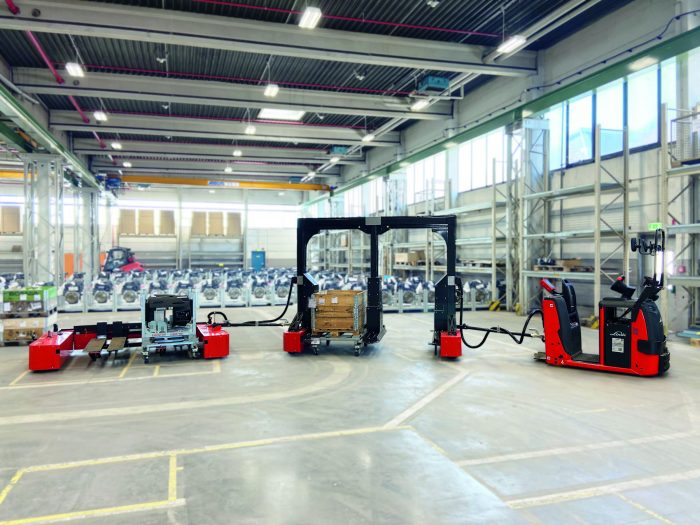Linde: Step by step more flexible, safer and efficient

With new trailers and a cloud-based tugger routing system, Linde Material Handling (MH) is making bundled, horizontal goods transport even more attractive. Innovative functions for trailers with C-frames and hoop frames ensure greater safety and flexibility. The tugger train guidance system determines the optimal route for operators, reduces error rates and employee training times, and responds to order changes with adjustments in real time. Even complex tasks become manageable and can be reliably processed.
Horizontal goods transports with tugger trains show their advantages especially where large quantities of different parts and components have to be provided at the right place at the right time over a long distance. For example, in the automotive industry, where each vehicle consists of many thousands of components that are assembled piece by piece until the finished car rolls off the assembly line. “In this case, bundled transports with the help of tugger trains make more sense economically and ecologically than individual transports and follow the lean philosophy,” explains Mal Rexhepi, Product Manager Automation & Load Train Solutions. Further advantages of production supply by means of a tugger train are the reduction of internal traffic volume and the associated lower accident potential, combined with plannable processes.
More flexibility through new frame features
From September 2021, Linde MH will be launching new trailer models for the Linde Logistic Train – consisting of the LT-C with C-frame, the LT-B with bow frame and the LT-BM with bow frame and movable centre bar.
The improved functions of the frames offer even more safety and flexibility. New is the innovative and patented lifting profile mechanism for hoop frames. It not only enables the transport of a wide variety of roll frames, but also, with the appropriate design, the lifting of pallets without load carriers, for example, if these have been placed in the trailer with a pallet truck. The optional centre bar, which can be freely moved against the direction of travel, allows the use of several and different container sizes in the same trailer – without significantly increasing the train length.
The highlight of the C-frames is the system for stabilising the forks. The patented solution prevents the forks from sagging even with the highest possible loads and thus ensures safe transport of the load. The ergonomic ejection mechanism is also helpful: when the operator releases the lock by foot switch, the load is pushed away from the back of the forks, making it easier to pull the load carriers out of the trailer.
A mechanical load lock is fitted as standard in all Linde MH trailer models: as soon as a container is placed in the frame, the lock closes automatically. When the operator gets into the tractor, the trailers are automatically lifted. When he leaves his driving position, the load is lowered. During the journey, lowering of the trolleys is technically impossible. Conversely, the operator cannot set the tug in motion when the trailers are lowered.
For outdoor use, the frames can be equipped with weather protection, among many other options, to protect the load. The mechanical all-wheel steering ensures high directional stability of the tugger trains: no matter how many trailers are used – the entire train remains on track. Thanks to a standardised interface, the trailers are also prepared for semi- or fully automated operation. Trolleys have also recently been included in the scope of delivery. They are available in different versions and can be further equipped, for example with modular shelf superstructures.
Always on the right track with the tugger train guidance system
The changeover from individual to bundled material transports brings many advantages – but at the same time it increases the complexity for the warehouse staff. “It is a matter of designing routes and load carrier changes as efficiently as possible in order to avoid time losses and errors. To achieve this, the cycle from upstream production to final assembly must be planned and coordinated,” explains Oldrik Wagner, Product Manager Software Solutions. “With our tugger train guidance system, we now provide employees with step-by-step task support.”
The tugger train control system receives the relevant information on the material transports from the ERP or WMS system. From this, it generates the individual driving orders and displays them on a large touch display in the cockpit. The drivers are directed order by order along the calculated, optimal route to the assembly stations. Beforehand, the route trains, trailers, stops, routes and reports are displayed in the multilingual
For more information, please visit:
News Categories
- » NEWS HOME
- » Automation & Robotics
- » Industry 4.0
- » Material Handling
- » Sensors
- » Quality & Testing
- » Machine Vision
- » Laser & Optics
- » Metalworking
- » Motion Control & Drives
- » Hydraulics & Pneumatics
- » Process Industry
- » Renewable Energy
- » Agriculture
- » Home & Office Furniture
- » Environmental Tech



